This page contains references to diamonds or engagement rings from different companies. Sometimes I do receive a commission when you click on links and buy the products.
Within their formation, a process that takes thousands if not millions of years, diamonds will develop internal and external flaws, known as ‘inclusions’. These are natural, and present in almost all diamonds—some of which are so small they are imperceptible to the naked eye. This is called being ‘eye-clean’. Judging a diamond on its inclusions is known as judging clarity, with the highest clarity level available being ‘flawless’.
Lower down on the clarity scale are I1, I2, and I3 diamonds. These types of diamonds usually contain the most inclusions, and the majority of them will have inclusions that can be seen by the naked eye. Not only does this look bad, it also drastically impacts the light performance and return of the diamond. If inclusions are present, less light is refracted, meaning less fire, brilliance, and sparkle.
So should you purchase I1, I2, or I3 diamonds? Are they a good investment? How can you find potentially worthwhile examples? Read on to find out.
- What is Clarity? What is I-Grade Clarity?
- The Light Performance of I Clarity Diamonds
- I1 vs. I2 vs. I3 Diamonds
- Will You Get Value for Money?
- Should You Consider Lab Diamonds?
- The Expert Insight on I Clarity Diamonds
What is Clarity? What is I-Grade Clarity?
As we’ve said, clarity refers to the ‘purity’ of the diamond itself—whether the diamond has impurities either inside of it or on its exterior. You can find out all about clarity on our clarity education page. Clarity is split into a number of categories, determined by leading diamond authority organizations the GIA and the AGS. The GIA scale clarity like so:

According to the GIA, I clarity diamonds have ‘Inclusions that are obvious under 10z magnification and may affect transparency and brilliance.’ Diamond experts grade clarity based on a variety of features, such as:
- The size and number of inclusions or blemishes present.
- The position of those impurities.
- The type of those impurities.
Evidently, it’s a complex process, and more than one diamond grader is needed until consensus can be reached. Graders also need to content with the cut of a diamond, which can work to conceal inclusions or make them more visible. For example, an ideal cut will conceal inclusions due to the facet patterning. In contrast, cuts like Emerald or Asscher, which are known as ‘step cuts’, can increase the likelihood of inclusions being visible.
Are I Clarity Diamonds Eye-Clean?
Any diamond that is within the I clarity grade is highly unlikely to be eye-clean. Because of this, we wouldn’t really recommend them, especially if you’re looking for a diamond to set into an engagement ring.
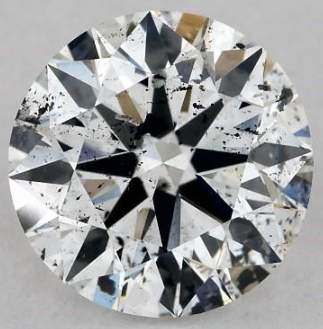
This diamond from James Allen is I1, and evidently not eye-clean. Those black marks are inclusions, and are most likely pockets of black carbon that have been embedded in the diamond since its formation. Image credit: James Allen
Any savvy diamond buyer should know that the first thing you should look for in a diamond is whether it is eye-clean or not. Even diamonds with OK cuts can look great if they have a high level of clarity—like the diamond below, which is internally flawless but has only a ‘good’ cut.
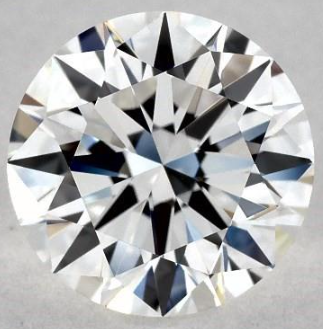
Image credit: James Allen
This isn’t to say that no I clarity diamonds are worth purchasing. Some may have a very specific inclusion set that can be covered by the setting you choose, meaning you could actually save yourself a lot of money. However, the chances of this are very rare, and you will need to utilize diamond retailers that offer high-res images and videos of the diamond in question (if you’re unable to view it in person).
The Light Performance of I Clarity Diamonds
Light performance is one of the most important characteristics of a diamond. These precious stones were meant to sparkle, it’s why we love them. So if they don’t sparkle, they’re not worth purchasing. If a diamond has a low clarity grade and a lot of inclusions, its ability to sparkle will be seriously affected.
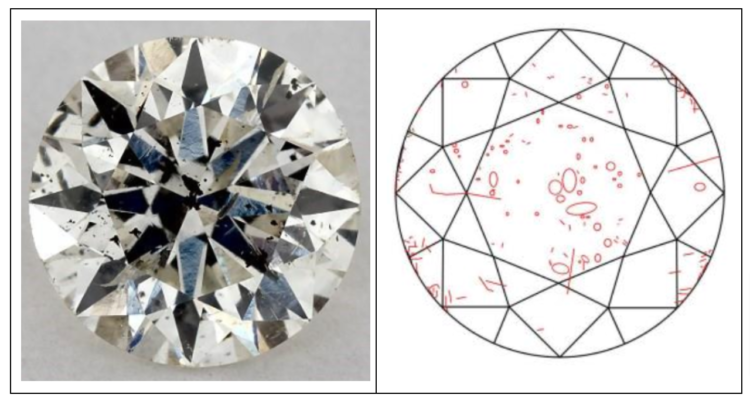
Look at this diamond, a 1.08 ctw I1 clarity diamond. As you can see from its GIA grading report, it has several different types of inclusions, such as crystals and feathers. All of these dark marks negatively affect its ability to sparkle and refract light properly. The inclusions create ‘optical flaws’ that impact transparency, meaning the amount of potential light return is decreased. This means less sparkly and less brilliance, meaning that the diamond essentially looks dull and even dirty.
I1 vs. I2 vs. I3 Diamonds
The I clarity grading is made up of I1, I2, and I3 diamonds. I1 will have the least inclusions, while I3 will have the most, so if you’re really looking for an I clarity, go for I1. That being said, we would never truly recommend opting for any I diamonds, as you’re highly unlikely to find one without visible inclusions. Even when the diamond’s inclusions can be covered by the setting, there may be an issue of lessened durability due to the inclusions weakening the structure of the diamond.
I2 and I3 are not worth using in fine jewelry, and it’s also best to stay away from retailers that sell them, or at least buy cautiously. In all honesty, anything below and I1 should be rejected. If a jeweler offers an I1, make sure it’s been properly vetted by either the AGS or the GIA, and make sure you can see it in person, alongside any relevant documentation.
Will You Get Value for Money?
I1, I2, and I3 diamonds don’t necessarily guarantee a good resale value, due to the fact that they’re not very in demand in the majority of the diamond market. Price wise, these diamonds are the cheapest, and so might seem appealing to someone on a small budget. However, they’re cheap because they’re of poor quality.
I would always advise a customer to consider VS2 diamonds first. These are some of the more affordable diamond examples on the market, and even though they may have inclusions, these inclusions are usually invisible to the naked eye. If you find a VS2 with a superb cut, you’ve got a fantastic diamond without the high price tag associated with flawless diamonds.
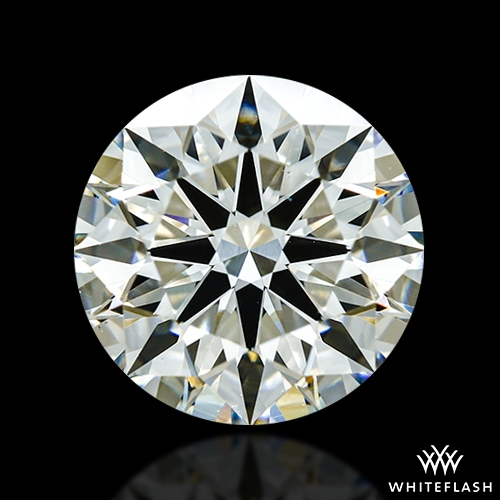
This 1.087 ct I VS2 A CUT ABOVE® Hearts and Arrows Diamond by Whiteflash is a brilliant example of how a diamond on the middle of the clarity scale can be just as impressive as its more expensive counterparts. Image credit: Whiteflash
Considering Lab Diamonds
When discussing diamond clarity and the value of diamonds, it’s essential to consider the rising popularity of lab-grown diamonds. These diamonds are created in controlled environments, ensuring they possess the same physical, chemical, and optical properties as mined diamonds. One of the significant advantages of lab diamonds is that they often come at a more affordable price point compared to their natural counterparts, without compromising on quality.
Why Choose Whiteflash?
Whiteflash is a renowned name in the diamond industry, known for their precision-cut diamonds. They offer a selection of precision-cut lab-grown diamonds that are not only ethically sourced but also of exceptional quality. If you’re specifically interested in their in-house collection, you can explore their range of lab-created diamonds here.
Other Notable Mentions
While Whiteflash stands out for its precision cuts, there are other reputable retailers in the market offering high-quality lab diamonds:
- James Allen: Known for their fancy shaped diamonds.
- Blue Nile: Offers a vast selection of diamonds.
- Brilliant Earth: Recognized for their lab diamonds.
Each of these retailers brings something unique to the table, ensuring that diamond enthusiasts have a plethora of options to choose from.
The Expert Insight on I Clarity Diamonds
If your budget is very tight, I would recommend trying to find an SI1 or SI2 diamond. With some hard work, you can find a good quality SI1 or SI2 that would suit being used in an engagement ring, but you need to closely evaluate what’s on offer and don’t just jump on the first diamond that interests you.
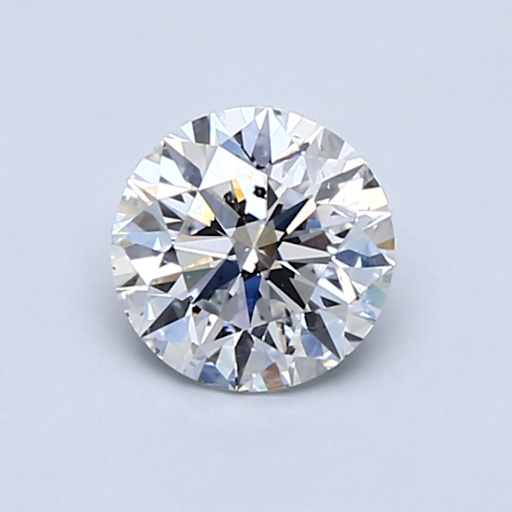
This 0.81 ctw SI1 diamond from Blue Nile shows you that you don’t have to spend a fortune on finding a Flawless diamond, you just have to be smart with how you search and how you spend. Image credit: Blue Nile
Where to Search for the Best Diamonds
There are countless diamond retailers out there, so who do you trust? In our years of working within the diamond field, we’ve come across four diamond retailing experts worth their weight in gold (or in this case, diamonds). These four are: You can see some of their diamond offerings in this post, yet their best is yet to be seen, and can be explored by you today by clicking on the links above. Or, you can read our detailed reviews of them by heading to our review section.

Richard Jenkins, The Diamond Guru
Get free assistance from the Diamond Guru today. You’ll be glad you did!
- Secure the best quality diamond for your budget.
- Don’t pay over the odds for your diamond ring.
- Have peace of mind that you didn’t get ripped off.
Have a Question? Contact us now…

